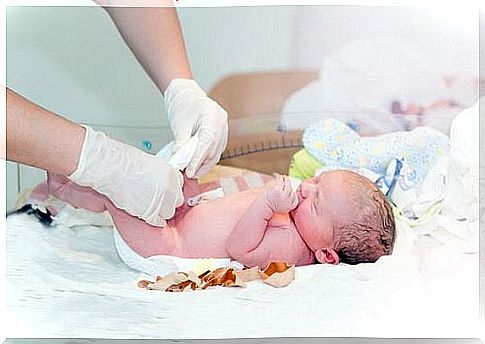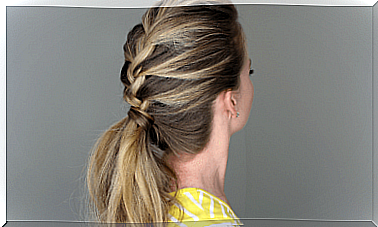Is The Umbilical Cord Around A Baby’s Neck Dangerous?

It is a fairly common occurrence for a baby to be born with the umbilical cord wrapped around its neck. This has been the subject of many fables. As a result, most people worry about the complications it can cause.
Of course, any steps that can be taken to avoid this phenomenon are the responsibility of doctors, nurses and midwives. There is nothing concrete that a mother can do to prevent this condition.
In fact, it is so beyond the mother’s control that many mothers are not made aware that the umbilical cord was around their baby’s neck until after birth. In about 40% of cases, the doctor only sees this problem during the delivery.
The umbilical cord around a baby’s neck
The umbilical cord can wrap around the baby’s neck at any time during pregnancy. It can even wrap around any other part of a baby’s body. It is also common for the umbilical cord to become entangled with the arms or legs. So, what is the cause of this?
Main causes:
- The umbilical cord is very long. Sometimes it can be as long as 55 centimeters.
- As a result of the baby’s movements in the womb.
- When Mothers Have Too Much Amniotic Fluid. This can cause the umbilical cord to accidentally wrap around the baby.

Childbirth procedures to loosen the umbilical cord
The umbilical cord can only be detached during childbirth. It is important to make it clear that there is no need to resort to cesarean section when the umbilical cord is around the baby’s neck. There are three techniques doctors use to loosen the umbilical cord.
The first technique is the simplest and most common procedure. This is used in almost 90% of the cases. The doctor waits for the baby’s head to come out of the vaginal canal and then slips the umbilical cord over the head. This act is sometimes all it takes to deliver the baby.
This technique is simple for two reasons. The first is that in most cases the umbilical cord is wrapped loosely around the baby. The second is because an umbilical cord has a gelatinous consistency. So it slips easily.
The second technique is used in only 9% of the cases. To perform this technique, the doctor will wait until the baby is completely out of the vaginal canal. Then the doctor holds the baby near the mother’s crotch and moves the baby so that the umbilical cord slides over his body. This technique is also known as ‘ the cat spin’ .
The last resort
The latter technique is only used in 1% of cases, but it is the one that parents fear the most. This procedure has contributed to the various fables about the wound of umbilical cord entanglements.
If doctors notice that the umbilical cord is wrapped around the baby’s neck beyond repair, depriving him of oxygen, he/she will cut the umbilical cord while the baby is still in the vaginal canal. They do this by first bringing in two hooks and then carefully cutting the child free with scissors.
Myths about this topic
There are many myths about the potential dangers to babies when the umbilical cord is wrapped around the neck or limbs. Complications occur in only 1% of cases and are usually not life-threatening for the child.

As explained above , the three techniques for loosening the umbilical cord around a baby’s neck can be efficiently applied by those skilled in the art. This occurrence can occur due to many factors, including the movements of the fetus in the womb.
If the umbilical cord is wrapped around the baby ‘s body , it does not have to be very risky for his health. This is a common occurrence in delivery rooms. Experts are therefore fully trained to solve this problem.
As a parent, don’t get carried away by alarming information. Instead, read the most current and accurate information on this topic. This will certainly put you at ease.









